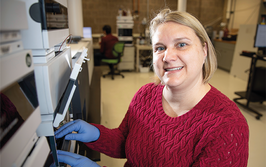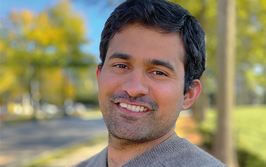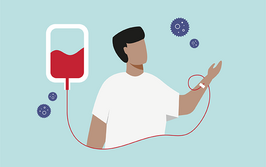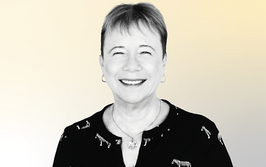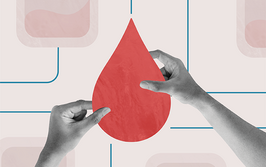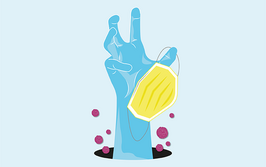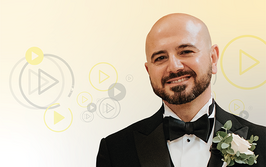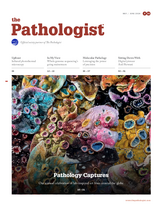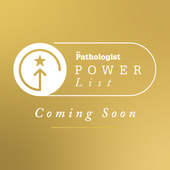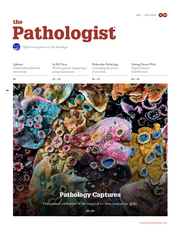
The sample is ready. I wheel over a chair, adjust the optics, and peer into the glass lens of the microscope. Just a few rooms over, a patient is lying on a table in a room surrounded by spotlights and masked medical personnel. Everyone in that operating room, conscious or not, is waiting for the answer we are about to find – an answer contained on a 75 x 25 mm piece of glass that only a pathologist can interpret. What we report in the next few minutes will direct the actions in the operating room moments from now – and potentially impact medical decisions made for years to come. That answer is found as I scan the slide, seeing the patterns and differences among the thousands of cells. Large cells with pink cytoplasm forming large pearl-shaped swirls and… “Squamous cell carcinoma.” The words slip out of my mouth just as the thought forms in my head. My statement is affirmed by the attending and the report is delivered to those waiting in the OR. Just like that a diagnosis is made, an answer is given, and a life is changed forever.
When I began shadowing pathology, I was not prepared for how rapidly I could label someone with a lifelong diagnosis. I did not associate pathology with that kind of weight and responsibility. However, I quickly learned how little I knew about a specialty that is essential to medicine. Therefore, I challenge other medical students to explore a field that attracts intellectually curious minds to provide diagnostic answers in medicine.
What is pathology? Think of a movie and its soundtrack. When watching a movie, you often fail to notice the soundtrack that guides the story along its path. But, if the soundtrack were removed, imagine how much the story would lose. That subtle component, once removed, is obvious in its absence – and the film is incomplete. Similarly, pathology guides much of the medical decision-making in the hospital. It can go unnoticed at times but, without it, the hospital would have a hard time treating its patients. Like a film score, pathology becomes obvious in its absence.
After my first two years in medical school, my view of pathology was admittedly narrow. I knew that a team of physicians called “pathologists” existed, but was not quite sure what they did. Some I remembered as educators, but mostly I associated the specialty with the slides of “metaplasia” or “atypia” I saw in test questions. Seeing those slides could trigger anxiety; they symbolized a challenging aspect of board examinations. Unfortunately, this fear of histology-based test questions affects the way medical students view pathology. Instead of seeing it as a constant force permeating almost every aspect of medicine, medical students shy away from the field without ever understanding its true nature. In my opinion, discovering pathology requires a genuine curiosity about clinical decision-making and mentors willing to guide that curiosity. Without these factors, many medical students overlook a foundational specialty because they lack the opportunity to explore it and therefore fail to understand what a pathologist truly does.
My curiosity developed when I was a third-year medical student doing an inpatient oncology rotation. I stumbled upon pathology by asking questions such as, “How are we differentiating these masses as specific cancer types?” or, “How are we finding these treatment-defining gene markers?” They all brought me to the same place: the pathology report. There, I saw the answers to clinically pertinent questions – but I wanted more. Reading a statement did not satisfy my curiosity. While it is necessary to know what clinically, I needed to know how those answers were determined intellectually. It was then that I truly began discovering how intertwined pathology is throughout all of medicine.
Thankfully, I reached out to an outstanding pathologist and exceptional educator at my institution who took the time to curate a month full of experiences showcasing the world of pathology. I saw surgical pathologists dissect, analyze, and diagnose specimens that ranged from small parathyroid adenomas to watermelon-sized liposarcomas. I participated in brain dissections, searching for signs of infarct or hemorrhage in a patient with an unknown cause of death. I investigated causes of death during autopsies, treated patients directly while shadowing transfusion medicine, and combed through fine needle aspirations in cytology. I toured the microbiology lab, where I saw bacteria that I assumed I would only ever encounter in textbooks – and so much more. The variety within pathology was joyfully overwhelming! I never once considered, before my experiences, how involved the pathologists at my institution are. Every culture swab, CBC, surgical specimen, blood transfusion, and more passes through the skillful hands of a pathologist before being relayed to the patients. In essence, most clinical decision-making would not be possible without the diagnostic or confirmatory information pathologists provide.
Consider a patient with a UTI who is treated empirically with antibiotics, but does not improve. Samples must be taken and analyzed by pathologists, who can then definitively say which bacteria has caused the infection and which antibiotic is best for the patient. What other specialty in medicine provides the skillsets and opportunities to have the final say on a diagnosis and therefore set the foundation for successful workup and treatment?
As well as the field’s expansive diversity, I saw a consistency of themes among the pathologists I met. First, they all truly loved what they did. Many attributed their passion to the variety, intellectual challenge, and ability to provide concrete answers within the world of medicine. Additionally, almost all referenced the ability to maintain their desired work-life balance. The positive effect of balance is evident in the low burnout ratings seen among pathologists, especially when compared with specialties such as family medicine and neurology. Second, the pathologists highlighted ongoing opportunities to educate in their daily workflow as another reason they loved their careers. One of the primary daily teaching opportunities is during “patient rounds.” Here, the team sits around a table together with a shared microscope that everyone can view simultaneously. As they round on the slides, or “patients,” presenters will discuss patient background information (as though we were standing outside the patient room) and correlate it with the pertinent information from the slide. In this way, every pathologist in the room is aware of disease characteristics and engaged in understanding, diagnosing, and treating the patient. From faculty to residents, it seemed that everyone had a deep understanding of disease function and development, making them ideal educators. In fact, I saw a profound continuity of this theme when thinking about my favorite medical educators outside my own school. Husain Sattar, who developed Pathoma, and Edward Goljan, the author and editor of many medical study resources, both happen to be pathologists. Coincidence? I think not. By engendering such a positive learning atmosphere in a specialty teeming with happy, fulfilled physicians, it is not hard to see why pathologists love what they do.
Why do people become physicians? Often, it is because we want to help our fellow humans in a significant way. We want to help them recover from whatever illness they are facing. In many medical students’ minds, that means sitting next to them in offices or patient rooms, providing clinical expertise, holding their hands, and treating their ailments. That is the “image” of a doctor we have seen all our lives. But we forget (or do not know) to consider the team of doctors combing through samples and specimens, diagnosing disease, and dictating clinical decision-making. Medical students must learn that diagnosis is no less crucial than the management and intervention methods with which we are so familiar. Without accurate clinical analysis from pathologists, other medical specialties would have a much more difficult time providing care.
The desire to become a better, more complete physician should drive all medical students to explore pathology. No matter what specialty you go into, an intellectual curiosity that spurs the pursuit of clinical answers will do nothing but better your future as a caregiver. Be the pulmonologist who can analyze a fine needle aspiration sample. Be the oncologist who wants to look through the cells of a bone marrow biopsy. Be the surgeon who looks at and discusses the specimen with the surgical pathologists. Or be the pathologist who can analyze, diagnose, and direct a patient’s treatment. Whatever you choose, be the physician who seeks out answers on behalf of your patients because you have the curiosity and motivation to do so.
Fourth-year medical student at Loyola University Chicago Stritch School of Medicine in Maywood, Illinois.

